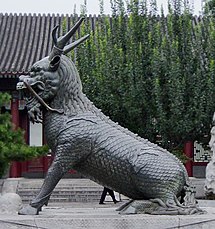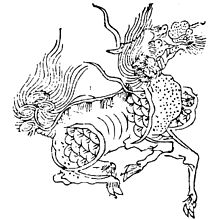Qilin
| Qilin | |
|---|---|
| Qilin of the Qing period , Summer Palace 2002 | |
| Chinese name | |
| Long characters | 麒麟 |
| Abbreviation | 麒麟 |
| Pinyin | Qílín |
| Jyutping | Kei 4 leon 4 |
| Pe̍h-ōe-jī | kî-lîn |
| Japanese name | |
| Kanji | 麒麟 |
| Hiragana | き り ん |
| Katakana | キ リ ン |
| Hepburn | Kirin |
| Korean name | |
| Hangeul | 기린 |
| Hanja | 麒麟 |
| MC | Kirin |
| RR | Girin |
| Thai designation | |
| Thai | กิเลน |
| Vietnam. designation | |
| Quốc Ngữ | Kỳ lân |
| Chữ Nôm | 麒麟 |
historical representations
The Qilin ( Chinese 麒麟 , Pinyin Qilin , W.-G. Ch'i-lin ) is a Chinese mythical beast . It is also known as the "Chinese unicorn ". In addition to the dragon - " Lóng ", the phoenix - " Fènghuáng " and the turtle - " Guī ", the qilin is one of the " four miracle animals ", which are also called magical beings.
Appearance and properties
In the Ming Dynasty , the animal was depicted with a dragon head with flame ornaments and ox hooves, as well as with fish or dragon scales. In the Qing Dynasty , deer antlers, a lion's tail and the beard of a carp were added.
The Qilin is said to have a peaceful nature and embodies the love of peace and goodness. It should only eat plants and never trample the grass it walks over or trample on beetles. The Qilin is therefore also called Rénshòu ( 仁 獸 / 仁 兽 ) in Chinese , meaning the "animal of goodness and humanity". In the word composition, Qí - 麒 denotes the male and Lín - 麟 the female animal, which expresses the dualism , but also the relationship between Yin and Yang . The Qilin is said to be a thousand years old.
Background and history
The appearance of a qilin was considered in earlier times as a sign of the arrival of a wise ruler. In Chinese mythology , it is also the servant of the just judge Gāoyáo ( 皋陶 , outdated graphic variant: 臯陶 ), who in turn serves the ideal emperor Yao . Sinners were always struck down by the horn of the qilin.
One book tells that a qilin was captured in the time of Confucius . The people did not know this sacred animal, and because they feared it was a bad sign, they murdered it. Confucius was very saddened by this and said he saw no more hope and left his historical book unfinished.
When the Chinese eunuch and admiral Zheng He brought two giraffes back to Emperor Yong Le from one of his famous sea voyages in the Ming Dynasty ( 1334 - 1644 ), courtiers declared her to be a qilin due to her calm nature and the fur pattern of courtiers has been preserved in Japan and Korea to this day, as the Japanese or Korean term for giraffe and the mythical animal (Japanese: Kirin , Korean: Girin ) are one and the same.
The Qilin is generally regarded as a symbol of happiness, peacefulness, justice and the blessing of children. This is why the Chinese also know him as Ruìshòu ( 瑞獸 / 瑞兽 ), ie an “animal that promises good”, the “lucky animal”. The legend In the Qing Dynasty it adorned the robes of officers of the first rank. According to the teaching of Feng Shui , qilins are often set up in pairs in the house or in front of gates. In China there is also the tradition of the qilin dance.
The Qilin is the master of the hairy class of animals . Other animal classes and their respective overlords are:
- scaled: the Chinese dragon - Lóng ( 龍 / 龙 )
- armored: the turtle - Guī ( 龜 / 龟 )
- naked: man - Rén ( 人 )
- feathered: the Chinese phoenix - Fènghuáng ( 鳳凰 / 凤凰 )
- Qilin dance
In traditional festivities, in addition to the lion and dragon dance, the qilin dance ( 麒麟 舞 , qílínwǔ ) as a symbol of good luck is performed, especially by the Chinese Hakka ethnicity.
- Qilintanz - New Year Festival , Sabah
Trivia
- Kirin
In Japanese , the characters Qilin - 麒麟 - Kirin are pronounced. In Japanese art it bears more resemblance to a deer than to the Chinese original. The two characters each contain the radical for deer 鹿 . In modern Japanese or Korean, the term Kirin (Kor. Girin ) is also used for the giraffe. The Japanese Kirin brewery is named after the Kirin.
literature
- Johny Cherry: mythical animals. About dragons, unicorns and other mythical beings. Reclam, Stuttgart 2009, ISBN 978-3-15-020185-5 , pp. 101-102
- Josef Guter: Lexicon of the gods and symbols of the ancient Chinese. Marix, Wiesbaden 2004, ISBN 3-937715-04-5 , pp. 266-267
- Wolfgang Münke: Mythology of the Chinese antiquity. With an outlook on future developments. Peter Lang, European Science Publishing House, Frankfurt am Main 1998, ISBN 3-631-32776-5 , p. 55
See also
Web links
- Chinese Qilin ( Memento from October 13, 2006 in the Internet Archive ) (Japanese)
- Kirin in Imari (Japanese)












